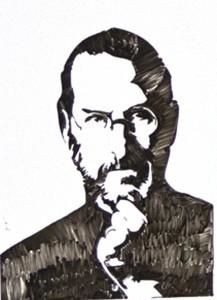Magnatag InSight
The whiteboard and how it helps us brainstorm, innovate, motivate and create
RECENT BLOG POSTS
- How to Eliminate Scheduling Chaos with the Right Business Calendar
- The Educators’ Choice: 8 Leading Whiteboards for Group Learning
- Glass vs Porcelain vs Melamine: Which Magnetic Dry Erase Surface Lasts Longest?
- Full‑Wall Whiteboard Panels vs Paint: Performance, Cost, and Longevity Compared
- The Definitive Guide to Creating High‑Quality Branded Whiteboards with Magnatag
- Glass vs. Porcelain: Which Whiteboard Surface Fits Modern Offices Best?
CATEGORIES
How a Whiteboard is the Perfect Tool to Spark That "Aha" Moment
Tue Nov 19 2013Steve Jobs famously said “Creativity is just connecting things." When you ask creative people how they did something, they feel a little guilty because they didn't really do it, they just saw something. It seemed obvious to them after a while.” Steve Jobs was right about connecting independent ideas. A study performed by neuroscientist Dr. Mark Beeman, published in 2009 showed that a sudden moment of brilliance, although seemingly disconnected from proceeding thoughts, is a “culmination of a series of brain states and processes operating at different time scales.” The practice of collecting and organizing seemingly disconnected thoughts and ideas can help us make the connection and see opportunities and solutions to seemingly complex problems.

Now that we know our “Aha” moments are actually the connections we suddenly see between thoughts, ideas and experiences. Lets add some fuel to this fire and investigate how we foster and encourage more thoughts and ideas. For this I turn to a 10 year Harvard research study that shows substantial evidence that coworkers who work in close proximity perform at higher levels and find more creative solutions to problems. Marissa Mayer, the CEO of Yahoo made the controversial decision to discontinue Yahoo’s work from home policy, arguing that teamwork and employee interaction is imperative to Yahoo’s success. So if teamwork and employee interaction produces greater performance, and creative solutions come from connecting ideas, then we can conclude that teamwork either increases the chances of seeing connections or teamwork increases the quantity of ideas or thoughts making the likelihood of seeing a connection greater. Either way we know that the recipe breaks down to lots of people working in close proximity, produces innovative solutions.
The last element I’d like to look at is how our environment effects the way we develop these connections. As we discussed earlier, “Aha” moments are unpredictable and often come to us when we least expect it. This can be very frustrating to those of us whose job depends on producing creative content. Many try to schedule brainstorming sessions and meetings with the goal of coming up with something creative. These sometimes work but more often I find that the best ideas come to us after the meeting, when we have all had a chance to process the ideas and make the connections. The journal of Applied Cognitive Psychology cited a 2010 study that proved that “brainstorming sessions” were 86% more effective when participants were allowed to take a break and think about something different for a few minutes. You need to look no further then your local advertising firm to witness the many ways companies use their environments to try and make the process of brainstorming more casual. These environments are full of stimuli and other elements designed to casually connect people and their ideas. Some of the most innovative companies today have invested millions of dollars into lunchrooms, cafés and lounges, slides and gyms all designed to keep people at work sharing ideas in a casual setting. These appear to be working judging by the success of the companies that have adopted these approaches. However, I often question whether these environments are more effective at generating thoughts and ideas then they are at helping people to make those crucial “Aha” connections. I think it takes a more deliberate process to see all the ideas and visualize how they could connect.

Have you ever felt one of those moments coming on? One of those moments where you can feel the small connections starting, but you just can’t make sense of the clutter. It’s one of those moments when you’re struggling to fit all the pieces into a cohesive idea. It’s one of those moments when you see a connection but struggle to explain the idea to a coworker. It’s moments like these when I turn to my whiteboard. Now as an owner of a whiteboard company I arguably favor my whiteboard. However, during our 46 years of providing people with whiteboards, and hearing day after day how they help people to show what’s happening, I do believe that a whiteboard is the best tool for organizing thoughts in a visual way that helps people to make these creative connections. For example, Bob Langer originally conceived of the idea for his company “Living Proof “ on a whiteboard. He has developed 800 Patents and 25 companies with help from his team and their whiteboard. Steve Jobs famously used a whiteboard, in the first days of his return to Apple, to layout his vision for Apple’s future. These examples and many others show how organizing your ideas on a whiteboard and then taking a step back and looking for the connections can be the difference between having that “Aha” moment and missing it.